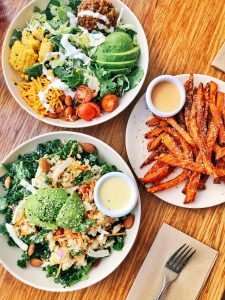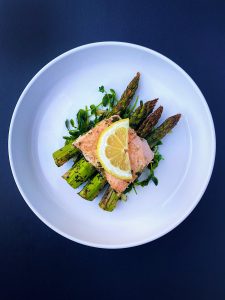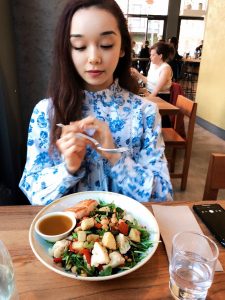While it’s true that taking care of your health is important for all individuals to avoid catching illnesses, developing health issues, and live a long happy life, I believe that dancers, in particular, should pay close attention to their health and nutrition since they use their bodies very physically.
Over the years I have gained knowledge about nutrition and health from multiple different sources through books, articles, podcasts, documentaries, and also from other senior dancers/colleagues. (Disclaimer) although, that being said, I am not a doctor, nutritionist, or registered dietitian so please consult one of those before making any changes to your diet and lifestyle.
In this series of nutrition-related-blog posts, I will be sharing tips and tricks that I’ve learned and worked for me (so adjust to your liking accordingly and take everything with a grain of salt). I say this because it took a LOT of trial and error to figure out what foods and type of “diet” suits me and my daily lifestyle, and even still I’m constantly changing and tweaking things as I grow older and also my workload increases.
So, without further ado, the first subject manner I wanted to cover in this blog post series is how to develop a healthy relationship with food since I know many dancers struggle with this, myself included. One major topic I think should be addressed is how you can find balance in your daily diet and also learn to distinguish between eating for “fuel” versus eating for “pleasure”.
Eating for fuel essentially entails that you simply consume foods that will provide you with energy for whatever activity you are doing. Some examples of foods that provide fuel (but may not be as exciting for the taste buds) include lean proteins (like chicken, turkey, eggs, and fish) and complex carbohydrates (like whole grains, gluten-free oats, and sweet potatoes) alongside leafy greens (spinach, kale, collard greens, arugula, etc.).
In contrast, eating for pleasure entails that you eat certain foods that bring you joy even if it may not be the “healthiest choice.” Some examples of “guilty pleasure” foods include desserts (like ice cream, cakes, cookies, donuts, crepes, and pastries), “junk foods” (like chips, candy, soda, pizza, and other fried foods), and comfort foods (like mac and cheese, pasta, hearty stews, burgers, pancakes, and waffles).
With these thoughts in mind, there are certain times when it is best to utilize each “style” of eating. For instance, eating a big bowl of ice cream or a huge helping of fried foods would probably not be a good idea right before a dancing in a performance. But this does not mean that you can never eat nor enjoy these kinds of foods. Just know that there is a time and place for both.
This brings me to my favorite phrase said by Oscar Wilde which is “everything in moderation , including moderation.” Essentially, this saying means that you should eat them (yes including “junk foods,” sweets, carbs, or whatever it may be), just in moderation by having a small portion/serving then move on. This way you can still maintain your health, fitness, and weight-management goals without feeling deprived of your favorite foods.
, including moderation.” Essentially, this saying means that you should eat them (yes including “junk foods,” sweets, carbs, or whatever it may be), just in moderation by having a small portion/serving then move on. This way you can still maintain your health, fitness, and weight-management goals without feeling deprived of your favorite foods.
Another thing a dancer can do to help develop a healthy relationship with food is to listen to their hunger cues and eat when they are hungry. When you spend your whole day staring at yourself in a mirror and critiquing how your body looks, it is no wonder why so many dancers choose to starve themselves since most of their day is spent in a leotard and tights (and no one likes that terribly bloated feel and look). The problem with this is by the time the dancer gets home from dance practice or a long day of rehearsals, they are much more likely to eat a larger amount of food in a shorter period because they were ignoring their hunger cues.
Furthermore, one last idea to consider on the topic of building a good relationship with food and developing healthy eating habits is allowing yourself to have the flexibility and not beat yourself up if you “cheat” on your diet. As mentioned earlier, it is important to make sure that you leave room to enjoy the foods you love, especially when you are in the company of loved ones and for special occasions like holidays, birthdays, parties, and special events. I used to struggle a lot with going out to eat at restaurants because I hated not knowing how the food was cooked or what ingredients were used. “How much salt/sugar did they add to this?” “Why is the food cooked in so much oil?” “There are HOW many calories in this whole meal?” These are just some examples of thoughts I used to have while eating out, thus preventing me from enjoying my meal and time spent with family or friends.
Therefore, what I hope you take from this post is that developing a healthy relationship with food takes time, effort, and patience to achieve balance and find a happy medium in eating. Also, knowing it is okay to make mistakes along the way when trying to create a “diet” or “eating lifestyle” that works for you. While it is no lie that ballet is a very aesthetic art form, without proper fuel (eating adequately), the dancer would not be able to perform their craft to their best abilities.






Well written article on a healthy diet for our modern times. 75 years ago, folk ate significantly less refined sugars and factory processed foods and had a more raw and natural diet. Finding the right balance for you does involve a lot of trial and error so being mindful of what we eat and trying to eat healthier is important for our long term health, as is adequate exercise (dancers get enough) adequate sleep, and good social support.
Thank you for this thoughtful post. My sister is a dancer and I am hoping she continues to have a relatively healthy relationship with food. I have to admit that it does worry me.